| |
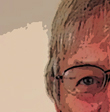 Opinion Opinion
From Ken Burnett
 plus special guest contributor, plus special guest contributor,
Giles Pegram CBE.
Blog 28 November 2016
Continuing an occasional series featuring issues
of interest to
the Commission
on the Donor Experience.
Has anyone considered a formal ‘donor sub-committee’ of the board of trustees?
There is an assumption
that people
don’t want our communications. Every communication should make the donor feel better about their support than he or she did before it arrived.
Radiators spread the warm glow of making a difference, drains suck out passion and emotion, commoditising giving till it becomes like any other transaction. ...Anyone not openly passionate about his or her cause should be encouraged to leave.
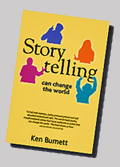 Storytelling can change the World Storytelling can change the World
is reviewed here and here and you can buy it here.
|
Much has changed since the Commission on the Donor Experience was initiated in mid 2015. Early in the process Giles Pegram and Ken Burnett each set themselves the task of listing 10 things they’d most like to see change. Now, as completed projects (the CDE has 30+ of them, see here) are beginning to be handed in, it’s interesting to reflect on whether the changes they envisioned back then might now actually come to pass.
Ten things I’d change now, to make fundraising better for donors.
Suggested by Giles Pegram CBE, vice-chair of the Commission on the Donor Experience.
1. The voluntary sector has to be encouraged to see fundraising as an investment, not an expense.
How can we get trustee boards to think of fundraising in competition with bonds or shares), not as an overhead in competition with services? How do we stop CEOs cutting 10 per cent off all budgets without realising that expenditure on fundraising is what drives income?
2. Trustees and CEOs should be required to measure long-term results and impact, not just short-term income.
Too many fundraisers talk relationships, but manage short-term performance judged solely by monthly performance against budget. The very walls of our offices whisper ‘budgets’, the antithesis of long-term thinking.
3. Our sector should develop systems to measure satisfaction, as well as money.
What metrics beyond money now should fundraisers be measuring? In future fundraiser’s metrics will focus on satisfaction, loyalty and LTV, as well as current income.
4. Treat companies and trusts as donors.
Fundraisers should be treating companies and trusts as collections of individuals, each of whom should be treated as a donor and given a great experience.
5. Enhance the donor experience, don’t over-regulate it.
Almost all the regulation and compliance that is getting so much attention is about fundraising as an activity. Something that is done to people. It’s all about things not to do. Fundraisers should focus instead on the joy of giving, something that is inherently positive.
6. Change the way donors see our communications.
Fundraisers should communicate with their donors often enough that they become a welcome part of their lives. There is an assumption that people don’t want our communications. Every communication should make the donor feel better about their support than he or she did before it arrived.
7. Get trustees to listen to donors.
How many trustee boards have one or more trustees who are trustees because they are donors? Articulate, intelligent, and part of the lifeblood of the charity? I’m not talking about a £50,000 donor, but a £5-a-month donor. How many trustee boards have donor panels? Donors whose advice can inform trustees’ decisions, from their own experience of being a donor? Has anyone considered a formal ‘donor sub-committee’ of the board of trustees? Alongside, and as important as, the finance sub-committee and the services sub-committee? To review all fundraising. (Fundraising that has happened, not part of the approval process.) They could really add value by advising fundraisers and making recommendations to the trustees.
8. Spend more on retention and less on acquisition.
How have we got the balance so wrong? Retention is the door to the future of fundraising. With acquisition becoming more and more expensive, retention is the way forward. Why, in principle, should we not spend at least as much on retention as we spend on recruitment? The more we invest resources in creating a good donor experience, the longer donors will stay and the more they will give.
9. Treat supporter care staff as fundraisers, not back office staff.
Supporter care staff are front-line fundraisers. They spend all their time communicating with individual donors. Do we give as much time to supporter care as fundraising? Each of these staff hold the relationship with the donor in their hands, with every contact. And every contact should increase satisfaction.
10. Re-invent how fundraisers use the telephone.
The telephone is a wonderful tool for communicating with donors, and enhancing the donor experience. A good caller will acknowledge the donor’s involvement with the charity, stress that she is known, thank her for the difference she has made to the beneficiaries of the charity and inform her about work that she and other donors have made possible. The caller will answer her questions. And, yes, from time to time, give her the opportunity to increase her direct debit, or give an additional gift. And feel good about it. She will feel better after the call than before it.
This level of personal engagement would not be possible in a letter, or an email. It is unique. This good caller should be paid as much as any fundraiser working for the charity.
Continued top of column 2, above.
Related earlier articles:
• Doing the right thing by donors.
• Pure gold: the 34 essential foundations of fundraising.
• Continous donor choice: fundraising’s best opportunity in ages.
• Giving donors choices: a fundraising preference service from 1986.
• Who’d want to live next door to a lapsed donor?
Home page | Current blogs | Article archive
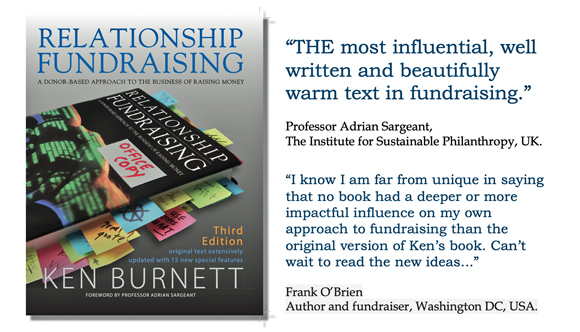
|
|
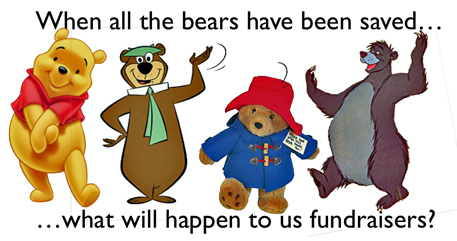
Alan Clayton tells a thought-provoking story of an organisation his agency worked with on their campaign to save the bear. After some years of increasingly successful fundraising, one day the client called Alan into his office and with a very long face explained that the agency was to be fired. ‘There are simply no more bears to save, the client said, looking crestfallen. ‘I’m terribly sorry.’
To the client’s surprise, Alan was delighted. ‘That’s great, he replied. ‘We’ve been hoping for and working for this day for years.’ The client still looked bereft, then realisation dawned.
Yes, there is a new way of looking at this. We saved the bears!
Continued from column 1, below.
Ten things I’d change now, to make fundraising better for donors.
Suggested by Ken Burnett, author of Relationship Fundraising: a donor-based approach to the business of raising money and other books.
1. Back to basics, regularly for everyone.
Recruit the right people with the right passion, commitment, skills, attitudes and mind-set. Make sure they’re steeped in all the basics and revisit them regularly (see SOFII here).
2. Sector leaders must step up to change the culture of fundraising.
An integrity-led consistent commitment to doing the right thing by donors, not just doing what makes most money, should lead to a radical overhaul of leadership’s crucial role in installing, leading and maintaining a robust, donor-led fundraising culture.
3. An end to hunting in the dark.
Fundraising is one of the few business areas where people can join with no requirement to know anything. All fundraisers should be required to learn what they need to know to be effective and to consistently inspire donors.
4. Elevate the importance of the donor experience.
Pushy persistence, interruption and intrusion are always counter-productive and wrong. Fundraisers should be able to inspire and delight without pressure or persuasion.
5. Mind your language.
Fundraisers should sweep away all inappropriate language when referring to donors. We should be very firm about this, using only language that is respectful to donors and that we’d always be happy for them to hear.
6. Give donors choices, to put the donor in the driving seat.
Donors should be offered practical, constructive, consent-based choices in how they are communicated with and how they wish to be treated. See here.
7. All fundraisers are equal.
Donor service staff, suppliers, agency staff, in-charity fundraisers, all are fundraisers and should treat every other fundraiser as an equal. There should be no second-class fundraisers, which means, in particular, that all who work in supplier agencies are treated as genuine fundraisers, same as all the rest.
8. Promote the radiators and fire the drains.
Radiators spread the warm glow of making a difference, drains suck out passion and emotion, commoditising giving till it becomes like any other transaction. Fundraisers should only recruit ‘radiators’ Anyone not openly passionate about his or her cause should be encouraged to leave.
9. Cultivate the art and craft of storytelling.
Fundraisers have the best stories to tell and the best reasons for telling them. As asking is increasingly restricted fundraisers have to learn to tell the truth well, with power and passion that will move people to action.
10. Fundraisers must become famous for frequent, fast, fabulous feedback.
Consistently. These are the five Fs. Donors need to know quickly and clearly the difference their gift has made. Fundraising should lead the way in tailor-made, prompt and appropriate feedback on how donations make a difference.
Not unambitious wish lists these, of course. But not unattainable either. If you believe that the certain road to happiness is to have low expectations, the coming transformation isn’t for you. For news on CDE’s progress and whether these dreams will actually, finally come true, please register with the Commission, by following the link below. And if you have suggestions of your own, please let us know.
This article first appeared on the 101fundraising crowdblog and The Agitator.

© Ken Burnett 2016.
NB: though Ken Burnett was joint initiator of the Commission on the Donor Experience (with Giles Pegram CBE) and is fully committed to helping it to achieve its goals, the views in these blogs are his own.(Well, some of these are also Giles's, obviously).
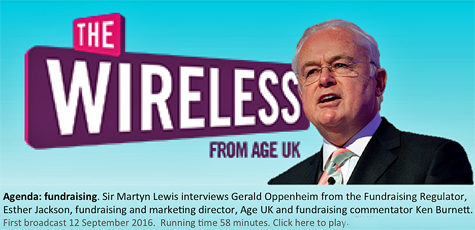
Click the image above to listen to a 4-way debate on the future of fundraising.
|






